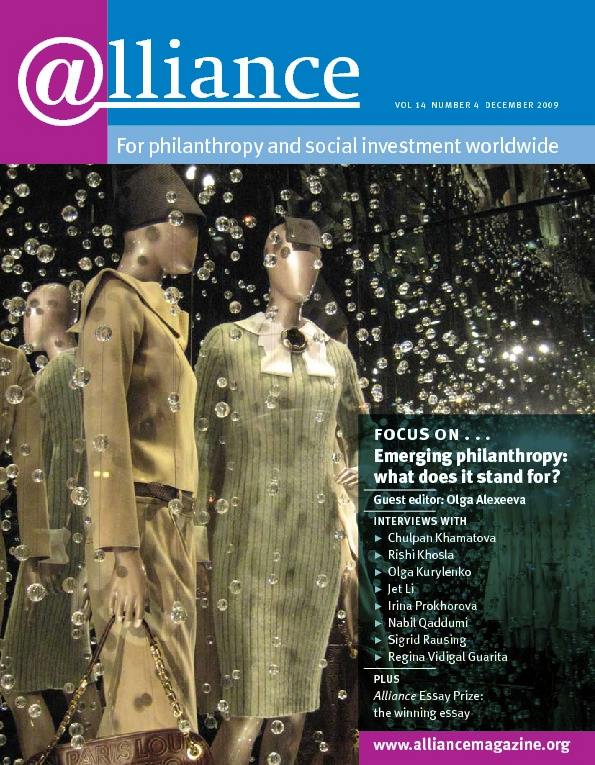Many foundations and non-profits run campaigns to increase public awareness of a particular issue and to motivate donations. Recently, some foundations have also begun thinking of their donations as a catalyst enabling a non-profit to raise even more funds from other donors. Similarly, non-profits often approach foundations seeking a gift that they can use to motivate other givers. One of the more common approaches in use is the ‘matching grant’, where a foundation pledges to match the donations of others, usually at a 1-to-1 or 2-to-1 ratio (so the foundation gives $2 for every $1 given by another donor).
 Talk to almost any fundraising professional and you are likely to hear that matching grants work wonders, and that the bigger the match, the more money raised. But this has yet to be proved. Recent experiments raise several questions about how, when and whether matching gifts work to motivate other donors.
Talk to almost any fundraising professional and you are likely to hear that matching grants work wonders, and that the bigger the match, the more money raised. But this has yet to be proved. Recent experiments raise several questions about how, when and whether matching gifts work to motivate other donors.
In one study, we sent direct mail appeals to 50,000 prior donors to a liberal politically motivated NGO.[1] These donors were randomly placed in one of three groups: a control group with no match, a treatment group with a 1-to-1 match, or a treatment group with a 3-to-1 match. People who received appeals with a matching grant were 22 per cent more likely to donate and the average donation was 19 per cent higher than those who received no matching offer. But when we compared the two match offers to each other, we found no difference. A 3-to-1 match did not motivate any more giving than a 1-to-1 match.
In a follow-up study with a similar NGO, we sent 20,000 leaflets to prior donors, offering matching ratios of 1-to-1 or 1-to-3.[2] This time, we found not only that a larger match didn’t have a larger effect, but that the matching grants didn’t have a statistically significant effect at all on either the total number or the average size of gifts. In fact, the match seemed to discourage donors who had not given recently.
Another study conducted by an IPA Foundation researcher took place in a laboratory environment and showed that donors may in fact choose to give less in the presence of a matching gift. In this study, donors passed up a matching grant in order to spread their donations to multiple NGOs working on the same issue.[3]
These results demonstrate that there are both good and bad ways to leverage other gifts. Merely offering a match may not produce the desired result; one needs to understand more about why people give in order to maximize the impact of a matching grant. How to do this depends heavily on the context of a situation. For instance, political environment and social cues may affect the response to an incentive. The first experiment was run during US presidential elections, and we found that the match’s effectiveness was driven by the behaviour of donors in politically conservative states. It is also likely that framing and anchoring are important factors to consider when designing matches. In the second experiment we found that the 1-to-3 match decreased giving when framed in larger terms ($25 to $75). Finally, the lack of a statistically significant effect in the second experiment should not suggest that the results of the two experiments contradict each other; rather, it underlines the importance of running many experiments to develop a coherent and consistent theory of giving.
This does not mean that there is no answer, or that the answer is constantly changing. But it does mean the answer isn’t as simple as ‘matches raise more money’. We continue to seek further knowledge by refining these tests, and exploring specific alternative contexts under which to test matches and build a clearer theory.
So what can you do with more questions than answers? First, you certainly shouldn’t assume that a bigger match is better: the finding that held most true across the two larger studies is that bigger is not better. Second, the next time you have the opportunity to make or use a matching grant, run your own experiment rather than just assuming a matching grant will work. Assessing effectiveness on different types of donor (eg recent givers, lapsed givers, givers of different ages or from different regions) will also help you make sure that future appeals have maximum impact. Ultimately you may find that there are much better ways to get leverage from a foundation grant than using it for a matching programme.
Dean Karlan is Professor of Economics, Yale University. Email Dean.Karlan@yale.edu
Kareem Haggag is Project Associate, Innovations for Poverty Action. Email khaggag@poverty-action.org
1 Dean Karlan and John List, ‘Does Price Matter in Charitable Giving? Evidence from a large-scale natural field experiment’, December 2007, American Economic Review, 97(5), pp 1774-93. http://karlan.yale.edu/p/MatchingGrant.pdf
2 Dean Karlan, John List and Eldar Shafir, ‘Smaller Matches and Charitable Giving: Evidence from a natural field experiment,’ October 2009, Working Paper.
3 Claire Null, ‘Warm Glow, Information, and Inefficient Charitable Giving’. http://are.berkeley.edu/~clair/Clair_Null_jobmarket_paper.pdf


Comments (2)